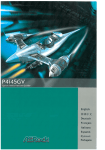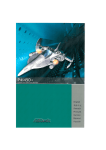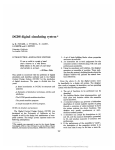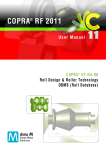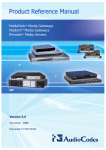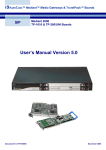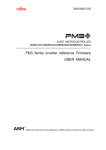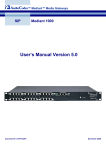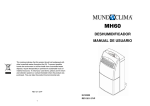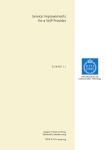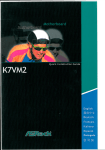Download User Manual for the OPERA™ E1/T1 Option OPR-002
Transcript
User Manual for the OPERA™ E1/T1 Option OPR-002-E1T-P This information may be subject to change. All brand and product names are trademarks and/or registered trademarks of their respective owners. All rights reserved. Copyright © 2001 by OPTICOM GmbH · www.opticom.de CONTENTS Contents Contents.............................................................................................................................................i 1 Preface......................................................................................................................................1 2 Setup of the Cable Connections...........................................................................................3 3 Setup of the E1/T1 Board Parameters ..................................................................................5 3.1 Configuration Parameters Overview...........................................................................5 3.1.1 Protocols ................................................................................................................5 3.1.2 Call Progress Tones..............................................................................................6 3.1.3 D-Channel Configuration.....................................................................................7 3.1.4 Line Code ...............................................................................................................7 3.1.5 T1 Framing Method..............................................................................................7 3.1.6 CAS ABCD Idle Pattern .......................................................................................7 3.1.7 Coding Law............................................................................................................8 3.1.8 Line Build Out........................................................................................................8 3.1.9 Destination Numbering Type..............................................................................8 3.1.10 Destination Numbering Plan ...............................................................................8 3.1.11 Source Numbering Type ......................................................................................8 3.1.12 Source Number Presentation...............................................................................8 3.1.13 Source Number Screening ...................................................................................8 3.1.14 Source Phone Number..........................................................................................8 3.1.15 Source Phone Subnumber...................................................................................8 3.1.16 Transfer Capability ...............................................................................................9 3.1.17 Inter Exchange Prefix Number.............................................................................9 3.1.18 B-Channel Selection .............................................................................................9 3.2 Using the OptiConf™ Application.............................................................................9 3.2.1 The Parameter Field “Protocol Type”..............................................................10 3.2.2 The Parameter Field “Protocol Version”..........................................................10 3.2.3 The Parameter Field “Protocol Subversion”...................................................10 3.2.4 The Parameter Field “Call Progress Tones Conf.”.........................................11 3.2.5 The Parameter Field “DChannel Configuration”............................................11 3.2.6 The Parameter Field “Line Code” .....................................................................11 3.2.7 The Parameter Field “T1 Framing Method”....................................................11 3.2.8 The Parameter Field “CAS ABCD Idle Pattern”.............................................11 3.2.9 The Parameter Field “Coding Law” ..................................................................11 3.2.10 The Parameter Field “Line Build Out ”.............................................................11 3.2.11 The Parameter Field “Termination Side” .........................................................12 3.2.12 The Parameter Field "Set B-Channel Parameters"..........................................12 3.3 Setting up B-Channel Configuration Parameters ....................................................12 4 Signal Acquisition Using OptiCall™.................................................................................17 5 OptiCall™ Command Line Parameters ...............................................................................19 6 Measurement Examples .......................................................................................................21 6.1 Example Parameter Settings for Several Protocol Types........................................21 6.1.1 E1_Euro_ISDN ....................................................................................................21 6.1.2 T1_CAS................................................................................................................22 6.1.3 E1_MFCR2...........................................................................................................25 6.1.4 E1_CAS_R2 .........................................................................................................26 6.1.5 T1_NI2_ISDN......................................................................................................26 6.1.6 T1_5ESS_10_ISDN.............................................................................................28 6.1.7 T1_DMS100_ISDN.............................................................................................28 6.2 Example 1: Stand Alone Loop Measurement...........................................................29 6.3 Example 2: Measurements From a Batch File ...........................................................32 i CONTENTS 7 Options for Advanced Users..............................................................................................33 7.1 Editing a Call Progress Tones Configuration File ...................................................33 7.2 Editing a CAS Protocol Table ....................................................................................34 7.2.1 Overview..............................................................................................................34 7.2.2 Constructing or Modifying a CAS Protocol Table ........................................35 7.2.3 Table Elements ....................................................................................................35 7.2.4 State’s Line Structure .........................................................................................38 7.3 Protocol Trace Option.................................................................................................44 7.3.1 Tracing CAS/Robbed Bit Protocols .................................................................44 7.4 Downloadables Construction Utility ........................................................................46 7.4.1 Location................................................................................................................46 7.4.2 Description...........................................................................................................46 7.4.3 Operation..............................................................................................................46 8 Technical Specifications......................................................................................................47 9 References .............................................................................................................................48 10 10.1 10.2 Glossary of Terms ............................................................................................................49 ANI.................................................................................................................................49 CLI..................................................................................................................................49 ii C H A P T E R 1 : P R E F A C E 1 Preface The documentation on hand is meant as a completion to the user manual of the OPERA™ measurement system. This documentation describes the E1/T1 Option (OPR-002-E1T-P) for the OPERA™ voice quality analyzer. Before you start reading this documentation, you should have studied the OPERA™ User Manual thoroughly, since the basic operation of components of the OPERA™ system is assumed to be known in the following. OPTICOM's E1/T1 interface option provides you with a large variety of protocols. In the current version the following protocol types are available: E1 Euro ISDN, E1 MFC-R2 CAS protocol including many country-specific variants, E1 CAS-R2 protocol including R2D and R2D modified variants, T1 CAS/Robbed Bit protocols including E&M wink start, E&M immediate start, E&M delay dial/start, loop start and ground start, and T1 National ISDN-2 PRI protocol. T1 ISDN implementations for particular switches are supported as T1 ISDN PRI protocol for the Lucent®/AT&T® 4ESS switch, T1 ISDN PRI protocol for the Lucent®/AT&T® 5ESS-9 switch, T1 ISDN PRI protocol for the Lucent®/AT&T® 5ESS-10, and T1 ISDN PRI protocol for the Nortel® DMS100 switch. In addition, a number of transparent protocols are available that provide the physical interface layer, without any signalling-related functions. The protocol types including all parameter settings for the interface board are fully software configurable. With the E1/T1 Option for the OPERA™ voice quality analyzer, you may modify the protocol parameters and even the entire state machine of T1 CAS, E1 MFC-R2 and E1 CAS-R2 protocols. You may also create your own call progress tones configuration files if the files provided by OPTICOM should not meet your requirements. In Section 2 of this document you will find a description of the board hardware. Section 3 provides information about the setup process of the interface board parameters, an overview of the available parameters and their meaning is given here. How to perform measurements with the E1/T1 interface is explained in Section 4, the new command line parameters for automated measurements from script files are described in Section 5. Measurement examples can be found in Section 6. Here, you will also find example parameter settings for several protocol types. 1 C H A P T E R 1 : P R E F A C E Advanced users will find descriptions for useful options in Section 7. On these pages, it is explained how to modify or construct CAS protocol tables and how to edit call progress tones configurations. In addition, you will learn how to trace protocols. The technical specifications for the interface board are listed in Section 8. The documentation concludes with references and a glossary of terms in Sections 9 and 10. 2 C H A P T E R 2 : S E T U P O F T H E C A B L E C O N N E C T I O N S 2 Setup of the Cable Connections The E1/T1 Option for the OPERA™ voice quality analyzer enables you to perform measurements with digital PSTN systems like Primary Rate Access (PRA) to ISDN, E1 CAS/MFR2 protocols or T1 CAS/Robbed Bit protocols. To connect the OPERA™ system to your system under test, two RJ-48 connectors are provided as shown in Figure 2.1. These trunks are labelled “1” and “2” on the back plate of the E1/T1 interface board. The Indicator LEDs shown above of the RJ-48 connectors are dual-colour LEDs that indicate the status of trunk 1 and 2, left to right. The LEDs are lit green for normal operation. If an LED is lit red either a loss of signal (LOS) or a loss of frame alignment (LFA) has been detected. Ethernet LEDs Ethernet RJ-45 Indicator LEDs 2 Trunks RJ-48 Figure 2.1: Rear View of the E1/T1 Interface Board. Note: The RJ-45 connector labelled “ETH” and the two Ethernet LEDs are not supported in the current version of OPERA™. In future versions, the Ethernet trunk will provide a connection to your IP network, thus giving the option of assessing voice quality in VoIP systems. In Figure 2.2 the connector pins for RJ-48 are shown. 3 C H A P T E R 2 : S E T U P O F T H E C A B L E Figure 2.2: RJ-48 Connector Pins 4 C O N N E C T I O N S C H A P T E R 3 : S E T U P O F T H E E 1 / T 1 B O A R D P A R A M E T E R S 3 Setup of the E1/T1 Board Parameters Before you will be able to start performing measurements with the E1/T1 interface board, the board’s configuration parameters will have to be set up. These parameters affect the board’s operation. For instance, the protocol type that is being used is defined at this point. After the user has finished setting all necessary parameter values, the initialization process is started during which the configuration parameter set is downloaded via the computer host’s PCI bus to the E1/T1 interface board. Note: The board configuration parameters are not “on-the-flychangeable” in the sense that changes will only take effect after the consecutive initialization process. Please note, that after the start-up of the OPERA™ host PC, the last chosen parameter configuration set of the E1/T1 board is immediately available. If this configuration meets your requirements, you may directly start the OptiCall™ application in order to perform measurements. For a description of the OptiCall™ application, please refer to Section 4. 3.1 Configuration Parameters Overview In this section an overview of the available configuration parameters and their meaning is given. Only those parameters are described that will have to be set up by the user. 3.1.1 Protocols The E1/T1 Option for OPERA™ offers a large variety of protocol types which are listed and described in the following. – ISDN PRI Pan-European (CTR4) protocol with many information elements and call control messages. E1 Euro-ISDN - Common E1 MFC-R2 CAS protocols including line signalling and compelled register signalling. National variants such as for China, Israel, Mexico, Philippines and more are available. You may change the protocol parameters and even the entire state machine by editing the protocol textual table that is downloaded to the E1/T1 interface board after the setup of the configuration parameters will have been finished. For a description of how to edit a CAS protocol table, please refer to Section 7.1. E1 MFC-R2 - Common E1 CAS protocols including line signalling and MF/DTMF address transfer. Available are R2D and R2D modified variants. You may change the protocol parameters and the state machine by editing the protocol textual table. For a description of how to edit a CAS protocol table, please refer to Section 7.1. E1 CAS-R2 5 C H A P T E R 3 : S E T U P O F T H E E 1 / T 1 B O A R D P A R A M E T E R S – Common T1 robbed bit protocols including E&M wink start, E&M immediate start, E&M delay dial/start, loop start and ground start. You may change the protocol parameters and the state machine by editing the protocol textual table. For a description of how to edit a CAS protocol table, please refer to Section 7.1. T1 CAS - National ISDN-2 PRI protocol with many ISDN information elements and call control messages. T1 NI2 ISDN - ISDN PRI protocol for the Lucent®/AT&T® 4ESS switch with many ISDN information elements and call control messages. T1 4ESS ISDN - ISDN PRI protocol for the Lucent®/AT&T® 5ESS-9 switch with many ISDN information elements and call control messages. T1 5ESS-9 ISDN - ISDN PRI protocol for the Lucent®/AT&T® 5ESS-10 switch with many ISDN information elements and call control messages. T1 5ESS-10 ISDN - ISDN PRI protocol for the Nortel® DMS100 switch with many ISDN information elements and call control messages. T1 DMS100 ISDN In addition to these protocol types, the E1/T1 Option for OPERA™ offers a number of transparent protocols. Transparent protocols provide the physical interface layer, without any signalling-related functions. These protocol types are listed below. – Transparent protocol, where no signalling is to be provided by the E1/T1 interface board. Time slots 1-31 of each trunk are mapped to the DSP channels hosted on the board. The first trunk is fully mapped, i.e. all 31 time slots, while the last trunk and its last time slots (30 and 31) will not have any DSP channel. E1 Transparent-62 - Transparent protocol, where no signalling is to be provided by the E1/T1 interface board. Time slots 1-31, excluding time slot 16 of both trunks, are mapped to 60 DSP channels on the board. E1 Transparent-60 - Transparent protocol, where no signalling is to be provided by the E1/T1 board. Time slots 1-24 of both trunks are mapped to 60 DSP channels. T1 TRANSPARENT - Transparent protocol, where no signalling is to be provided by the E1/T1 board. [AUDI01] J1 TRANSPARENT 3.1.2 Call Progress Tones The call progress tones to be detected, or generated by the board, respectively, are defined in a Call Progress Tones Configuration File. You can either use one of the files supplied by OPTICOM, or construct your own file. A description of how to edit a Call Progress Tones Configuration File can be found in Section 7.1. 6 C H A P T E R 3 : S E T U P O F T H E E 1 / T 1 B O A R D P A R A M E T E R S 3.1.3 D-Channel Configuration The D-channel configuration setting is applicable only to ISDN PRI protocols that support the NFAS and/or D-channel backup procedures. Only the US variants NI2, DMS, 4ESS, 5ESS-9, and 5ESS-10 are supported, and will be affected by this configuration. Table 3.1 lists the possible combinations. Trunk 1 Trunk2 Description Primary Primary Primary NFAS Primary Backup Normal and default configuration for PRI protocols for 23 bearer channels and one CCS (Common Channel Signalling) channel for each trunk. NFAS mode using Trunk 1 carrying the CCS channel. This trunk is also used to set-up calls for both trunks. Thus, Trunk 2 supports 24 bearer channels. Backup mode using the first trunk’s CCS has a primary signaling channel setting up the calls for both trunks. The second trunk supports 23 bearer channels and its CCS channel is used as a back-up or stand-by channel. In the case of malfunction, the second trunk changes roles with the 1st span and becomes the primary span. Table 3.1: PSTN Interface and Protocol Configuration for the E1/T1 interface board. Note: Currently only identical configuration setups of Trunk 1 and Trunk 2 are possible. This is about to change in future versions of the E1/T1 option. 3.1.4 Line Code Selects the line code type to be used for the trunks. Two common types of line coding are defined for E1, namely AMI or HDB3. For a T1 network valid line code types are AMI or B8ZS. 3.1.5 T1 Framing Method This parameter is applicable for T1 protocol types only. It specifies the framing format used by the trunk. T1 and E1 delineate frames differently. In the case of T1, either D4 framing (also known as SF or Super Frame) or ESF (Extended Super Frame) is applicable. In the case of E1 protocols, there is only one framing method defined. 3.1.6 CAS ABCD Idle Pattern The CAS ABCD Idle Pattern is the pattern that will be used whenever a channel is in idle state (at initialization - before opening the channel, or at all times when it is closed). In the frame format for E1 and for ESF on T1, this pattern consists of 4 bits – ABCD. When T1 with D4 frame format is used, there are 2 bits relevant – AB. This parameter is relevant only when using the E1/T1 interface with CAS protocols. 7 C H A P T E R 3 : S E T U P O F T H E E 1 / T 1 B O A R D P A R A M E T E R S 3.1.7 Coding Law The coding law parameter defines the companding characteristic that is used on the PC internal TDM bus. The companding characteristic is a formula which translates the amplitudes of the sampled voice signal into the 8 bit code words. Supported coding laws are A-Law and Mu-Law. The coding law must match the coding law of the speech file that is send through a system under test. Please note, this parameter does not refer to the telephone line coding law. 3.1.8 Line Build Out There are two parameters applicable for the line build out, the Line Build Out Loss parameter and the Overwrite parameter. The Line Build Out Loss parameter is used to control loss for different lengths of the line and applicable only to T1 protocols. The second parameter, Overwrite, enables users to write to the 3 Pulse Mask (XPM) registers, thus controlling the trunk’s analog pulse shape (applicable to E1 and T1 trunks). 3.1.9 Destination Numbering Type The type of the destination (called) number as defined in Q.931(ISDN only). 3.1.10 Destination Numbering Plan The plan number of the destination (called) number as defined in Q.931 (ISDN only). 3.1.11 Source Numbering Type In the case of ISDN, this parameter specifies the type of the source (calling) number as defined in Q.931. For MFC-R2 protocols, the source number type is used to provide the calling number category. 3.1.12 Source Number Presentation Presentation of source phone (calling) number as defined in Q.931 (ISDN only). 3.1.13 Source Number Screening Screening of source phone (calling) number as defined in Q.931 (ISDN only). 3.1.14 Source Phone Number Specifies the phone number of the calling (originating) party for protocols that use ANI (Automatic Number Identification) or CLI (Calling Line Identification). 3.1.15 Source Phone Subnumber Specifies the source sub address phone number for ANI. 8 C H A P T E R 3 : S E T U P O F T H E E 1 / T 1 B O A R D P A R A M E T E R S 3.1.16 Transfer Capability In the case of ISDN, this parameter specifies controls the BC (Bearer Capability) and optionally HLC (Higher Layer Capability). For MFC-R2 protocols, the transfer capability is used to provide the service category. 3.1.17 Inter Exchange Prefix Number This parameter is an option to send an additional phone number before the address (destination) phone number. The address phone number is selected in the OptiCall™ application. 3.1.18 B-Channel Selection This parameter defines whether the B-channel is used in exclusive mode. If a call is initiated in exclusive mode, the calling party exclusively defines the Bchannel to be used for the call. Alternatively, the PSTN is assumed to specify the B-channel to be used for the call (ISDN only). [AUDI01] 3.2 Using the OptiConf™ Application The configuration parameters are setup with the help of the OptiConf™ application. You start OptiConf™ from the Start Menu of your Windows™ platform by selecting the menu entry Start|Programs|Opera|OptiConf. The application will come up with the dialog shown in Figure 3.1. In this state, OptiConf™ will display the currently active configuration parameter settings for the E1/T1 interface. This configuration has already been downloaded to the interface board and is thus available for measurements. Figure 3.1: The OptiConf™ dialog main window. 9 C H A P T E R 3 : S E T U P O F T H E E 1 / T 1 B O A R D P A R A M E T E R S If these settings do not meet your requirements, you may change them. In a first step you might for example select an entry from the Protocol Type control listbox field. After having done so, the corresponding parameter values will be set in the other parameter fields of the OptiConf™ dialog. If necessary, you may modify one or more parameters now. This is done by either selecting an entry from the listbox field of a control or by directly entering the necessary value in an edit field where possible. Some parameter fields are shown in grey colour and thus may not be modified. These disabled configuration parameters are either not relevant for the protocol chosen, or there is only one valid value. After you will have finished setting all the necessary parameter values, you may start the initialization process by either clicking on the OK or the Apply button. After having done so, a message dialog comes up that informs you that the download process might take up to approx. 2 minutes. Please note, that the initialization process is started only after you have confirmed the message by clicking on the OK button. The application will then download the configuration set to the E1/T1 interface board. Note: Start OptiCall™ only after the initialization process is finished. Only then the chosen E1/T1 configuration is available to perform measurements. In the following the parameter fields and its valid values are described. For more detailed information about the parameters, refer to the overview in Section 3.1. 3.2.1 The Parameter Field “Protocol Type” Here you select the name of the protocol type. After choosing a protocol from the list, the corresponding default parameter values will be assigned to the parameter fields in the OptiConf™ dialog. For some protocol types, there are variants available that may represent country specific variants, for instance. These variants are available in the Protocol Version and Protocol Subversion control fields. 3.2.2 The Parameter Field “Protocol Version” This control offers a set of protocol variants that are available for some protocol types. If there are no variants available, the control will show “Not available”. 3.2.3 The Parameter Field “Protocol Subversion” Some protocol types provide another subset of variants which are available from this control field. For example, the MFC-R2 protocol provides variants for several countries in the Protocol Version field, and a subset of different protocol variants for the chosen country in the Subversion control. 10 C H A P T E R 3 : S E T U P O F T H E E 1 / T 1 B O A R D P A R A M E T E R S 3.2.4 The Parameter Field “Call Progress Tones Conf.” Selects the call progress tones configurations file. If no call progress tones are to be used the correct entry is “No call progress support”. 3.2.5 The Parameter Field “DChannel Configuration” The D-channel configuration can be set to Primary, NFAS or Backup. 3.2.6 The Parameter Field “Line Code” Specifies the line code type. Select AMI or HDB3 for E1 protocols and AMI or B8ZS for a T1 network. 3.2.7 The Parameter Field “T1 Framing Method” This parameter is applicable for T1 protocol types only. It is used to select “Super Frame (D4)” (12 frames multi-frame - SF) or “Extended Super Frame” (24 frames multi-frame - ESF) for T1. 3.2.8 The Parameter Field “CAS ABCD Idle Pattern” When defining the Idle Pattern, you may choose between an entry in the list field of the controls or you may enter a value in the control’s edit field. Please note, that the entered value needs to be a hexadecimal number. You may enter the value including the prefix “0x” or without it. In both cases your entry will be interpreted as a hex value. Valid entries are in the range between 0x0 - 0xf. For example, if you want to specify a pattern ABCD=1010, you have to enter the corresponding hex value which is 0xa. 3.2.9 The Parameter Field “Coding Law” This control selects the coding law that is used on the PC internal TDM bus. Available values are Mu-Law and A-Law. The coding law must match the coding law of the speech file that is send through a system under test. Please note, that this parameter does not refer to the telephone line coding law. 3.2.10 The Parameter Field “Line Build Out ” The Line Build Out Loss parameter can be set to 0 dB, -7.5 dB, -15 dB, or 22.5 dB. This parameter is disabled in the case of E1 protocols. The Overwrite parameter may be switched on by by enabling the checkbox. Then, you may define the values for the 3 Pulse Mask (XPM) registers. Please note, that these values have to be entered in hexadecimal data format only. As in the CAS ABCD Idle Pattern field, you may enter the value including the prefix “0x” or without it. In both cases your entry will be interpreted as a hex value. The Overwrite parameter is applicable to E1 and T1 protocols. 11 C H A P T E R 3 : S E T U P O F T H E E 1 / T 1 B O A R D P A R A M E T E R S 3.2.11 The Parameter Field “Termination Side” Some protocols are not symmetrical, that is, the user and the network side of the protocol are different. In the Termination Side control field you may change whether your OPERA host computer shall be configured as the user side or the network side of a protocol. 3.2.12 The Parameter Field "Set B-Channel Parameters" For some protocol types, like ISDN or MFC-R2, the parameters for the Bchannels need to be set.. In this field you may select from the drop-down list the B-channel you want to configure. After clicking on the "Configure" button, the dialog for the B-channel configuration will come up as shown in Figure 3.2. Please note, that only those channels are shown in the list that may carry voice information. That is, for instance, the D-channel of an ISDN configured trunk will not be found in the B-channel list. The numbering of the B-channels starts with zero. Note: Currently only identical configuration setups of Trunk 1 and Trunk 2 are possible. This is about to change in future versions of the E1/T1 option. 3.3 Setting up B-Channel Configuration Parameters Sections 3.1.9 to 3.1.16 describe a number of parameters that are to be set for each single B-channel of a trunk. Most of these channel configuration parameters are applicable for ISDN. Only some might be applicable for MFC-R2 protocols, too, which are Source Phone Number, Source Phone Subnumber, Source Number Type and Transfer Capability. For modifying B-channel parameter settings, choose the B-channel that your changes shall apply to in the main dialog of OptiConf™. When pressing the "Configure" button the dialog shown in Figure 3.2 will come up. Here, you will see the current settings of the selected B-channel. The parameter values for each B-channels are set separately, and modifying them for one specific B-channel will not affect the settings of another B-channel. You may also configure all available B-Channels in one step by selecting the entry “All Channels” from the drop-down list in the “Set B-Channel Parameters” field of the main dialog. In the following, an overview of the B-channel parameters is given. 12 C H A P T E R 3 : S E T U P O F T H E E 1 / T 1 B O A R D P A R A M E T E R S Figure 3.2: The B-Channel Configuration dialog window. Note: Please recall, when changing the channel configuration, your changes will only be available after you have re-initialized the E1/T1 board. Note: Currently, only channel configuration settings for Trunk #0 are supported. That is, that the channel configurations of the second trunk will be the same as for the first trunk of the interface board. . This is about to change in future versions of the E1/T1 option. Destination Numbering Type- Table 3.2 gives an overview of the values for the parameter Destination Numbering Type. Not Included Unknown Number International Number National Number Network Specific Number 13 C H A P T E R 3 : S E T U P O F T H E E 1 / T 1 B O A R D P A R A M E T E R S Subscriber Number Abbreviated Number MFRn1 MFRn2 MFRn3 MFRn4 MFRn5 MFRn6 MFRn7 MFRn8 MFRn9 MFRn10 MFRn11 MFRn12 MFRn13 MFRn14 MFRn15 Table 3.2: Parameter values for the Destination Numbering Type, respectively Source Numbering Type. Destination Numbering Plan- Table 3.3 gives an overview of the parameter values for the Destination Numbering Plan. NOT_INCLUDED Unknown Numbering Plan ISDN Numbering Plan Data Numbering Plan TELEX Numbering Plan National Numbering Plan Private Numbering Plan Reserved Numbering Plan Table 3.3: Parameter values for the Destination Numbering Plan. – The parameter values set is the same as for the parameter Destination Numbering Type. Please refer to Table 3.2. Source Numbering Type – Table 3.4 shows the parameter values for the Source Number Presentation. Source Number Presentation Not Included Presentation Allowed Presentation Restricted Presentation Not Aviable Table 3.4: Values for the Source Number Presentation parameter. – Table 3.5 shows the valid registry values for the Source Number Screening and their meaning. Source Number Screening Not Included User Provided User Passed User Failed Network Provided Table 3.5: Parameter values for the Source Number Screening. 14 C H A P T E R 3 : S E T U P Source Phone Number O F T H E E 1 / T 1 B O A R D P A R A M E T E R S – Enter a string representing the phone number of the source (origin). Source Phone SubNumber - Enter a string representing the phone sub- number of the source (origin). – Table 3.6 shows the parameter values for the transfer Capability when ISDN is used. Table 3.7 lists the values for the BC (Bearer Capability) and the optional HLC (Higher Layer Capability). Transfer Capability In the case of MFC-R2 protocols, you find in Table 3.8 the parameter values for the service category which is also selected from the Transfer Capability control. Not Included Voice Service Data Service Modem Service Audio 7 Service Table 3.6: Parameter values for the Transfer Capability in the case of ISDN. Voice Service Data Service Modem Service Audio 7 Service BC= speech, HLC= telephony BC= data BC= 3.1 kHz audio, HLC= telephony BC= 7 kHz audio Table 3.7: The meaning of the Transfer Capability parameter values for ISDN. BC is the Bearer Capability and HLC represents the Higher Layer Capability. MFRn_1 MFRn_2 MFRn_3 MFRn_4 MFRn_5 MFRn_6 MFRn_7 MFRn_8 MFRn_9 MFRn_10 MFRn_11 MFRn_12 MFRn_13 MFRn_14 MFRn_15 Table 3.8: Parameter values for the Transfer Capability in the case of MFC-R2 protocols. The list represents the service category. InterExchangePrefixNum – Enter a string representing the Inter Exchange Prefix Phone Number. B-Channel Selection– Table 3.9 lists the parameter values for the B-Channel Selection parameter . Any B-channel selection Preferred selection Exclusive selection of the B-channel 15 C H A P T E R 3 : S E T U P O F T H E E 1 / T 1 B O A R D Table 3.9: Parameter values for the Exclusive and their meaning. 16 P A R A M E T E R S C H A P T E R 4 : S I G N A L A C Q U I S I T I O N U S I N G O P T I C A L L ™ 4 Signal Acquisition Using OptiCall™ This section provides a short description of how to use the OptiCall™ application to perform measurements using the E1/T1 interfaces. For a more detailed explanation, please refer to Section 4.2.3 (page 39) in the OPERA™ User Manual Version 3.0. If you are already familiar with using OptiCall™ with POTS telephony or audio interfaces, you will not face any need for reorientation when performing measurements with the E1/T1 interface option. There are only a few things you need to notice which are explained in the following. Figure 4.1: The OptiCall™ dialog showing selected E1 MFC-R2 interface devices. As shown in the example screen shot of OptiCall™ in Figure 4.1, the protocol type you have selected within OptiConf™ (see Section 3.2), is shown as a part of the device name in the list box for the origin and termination device, respectively. The protocol name is then followed by the port number that represents the index of a trunk of the E1/T1 interface board. For instance, “Port 0” represents the first trunk. Each E1/T1 device name is terminated by the B-channel notation – e.g. “BCh 0” would represent the first valid voice bearing channel of a particular trunk. Please note, that only those channels of a trunk are registered in the device list that may carry voice information. That is, the D-channel of an ISDN configured trunk will not be found in the device list of OptiCall™, for instance. Consequently, all E1/T1 entries found in the list boxes of OptiCall™ may be used for measuring. The numbering of those channels starts with zero. 17 C H A P T E R 4 : S I G N A L A C Q U I S I T I O N U S I N G O P T I C A L L ™ Note: The DDLC™ mechanism that compensates for latencies of the Windows NT operating system is not available for the current version of the E1/T1 interface option. This may result in a lower accuracy when measuring the delay of signals. However, this restriction is about to change in future versions. 18 C H A P T E R 5 : O P T I C A L L ™ C O M M A N D L I N E P A R A M E T E R S 5 OptiCall™ Command Line Parameters This section describes the new features for the automated execution use of OptiCall™ from scripts. For more detailed explanation of the functionality of the command line parameters, refer to page 46 in Section 4.2.3 in the OPERA User Manual Version 3.0. Note: The command line parameters described in this section correspond with the OptiCall™ application but not with OptiConf™. Please remind that you have to configure the E1/T1 interface board using the OptiConf™ dialog before using the automated execution option. Three new parameters have been added to the automated execution which are listed in Table 5.1. The Mirror parameter defines that the terminating interface index is the originating interface index + an offset. That is that in the case of an E1 CAS protocol with 30 B-channels an offset value of 30 would be useful, for instance. In that case, you are able to mirror the Bchannel #0 of trunk #0 to the B-channel #0 of trunk #1. By doing so, you may simply omit the parameter definition for the terminating line. The Repetitions parameter defines how often a specified call shall be repeated. When using the Bulk parameter with a parameter value of n, calls will be automatically performed on n consecutive lines starting from the defined line for the originating and the terminating line, respectively. For example, if you have defined a call with OriginatingLine=4 and TerminatingLine=10, and Bulk=2, the following calls will be performed: from line 4 to 10, from line 5 to 11 and from line 6 to 12. Parameter name Parameter value Description -Mirror <offset> Terminating interface is originating + offset -Repetitions <n> Perform n calls -Bulk <n> Perform calls from n consecutive lines Table 5.1: Description of the additional command line parameters. Note: These parameter options are applicable to POTS and audio interfaces, too. 19 C H A P T E R 5 : O P T I C A L L ™ C O M M A N D 20 L I N E P A R A M E T E R S C H A P T E R 6 : M E A S U R E M E N T E X A M P L E S 6 Measurement Examples This chapter will be helpful if you are not yet familiar with the OPERA™ E1/T1 option. The first section provides some example parameter settings for all protocol types available. Section 6.2 demonstrates a typical loop measurement using OptiCall™, while 6.3 will show a typical application of an automated measurement using a script file. Both examples put the emphasis on the signal acquisition. If you are looking for examples of how to use the OPERA™ analyzer, please refer to the OPERA™ user manual. 6.1 Example Parameter Settings for Several Protocol Types In the following, a number of tables containing parameter configurations are listed. These tables represent example settings for all protocol types available, except for the transparent protocol types. The parameter configuration is divided into two sets, the trunk parameters and the Bchannel parameters. In the case of those protocol types that do not support any B-channel parameters, you may simply omit the configuration of those parameters. Some of the supported protocols are not symmetrical, that is, that the user and the network side of the protocol are different. The relevant configuration field is “Termination Side”. Please note, that currently only identical configurations for all trunks of a board are supported. As a consequence, it is currently not possible to configure one trunk as the user side and the other as the network side of the protocol. 6.1.1 E1_Euro_ISDN E1_Euro_ISDN is a non-symmetrical protocol. Please corresponding termination side for the user or the network. select Field Name Value Protocol Type Protocol Version Protocol Subversion Call Progress Tone Configuration Dchannel Configuration Line Code T1 Framing Method CAS ABCD Idle Pattern Coding Law Termination Side Overwrite Register Values E1_Euro_ISDN CPIsrael Primary HDB3 Alaw User, respectively Network Off Table 6.1: Trunk parameter settings for E1_Euro_ISDN. Field Name Value Destination Numbering Type Destination Numbering Plan Source Numbering Type Source Number Presentation Source Number Screening Source Phone Number Source Phone Subnumber Transfer Capability Inter Exchange Prefix Number Unknown Number ISDN Numbering Plan Unknown Number Presentation Allowed User Provided Voice Service 21 the C H A P T E R 6 : M E A S U R E M E N T E X A M P L E S B-Channel Selection Exclusive Selection Table 6.2: B-channel parameter settings for E1_Euro_ISDN. 6.1.2 T1_CAS For T1_CAS, there is a number for variants available which are listed in the tables of this section. For T1_CAS protocols, the B-channel parameters are not relevant and can thus be omitted. E&M Wink Start Variant Field Name Value Protocol Type Protocol Version Protocol Subversion Call Progress Tone Configuration Dchannel Configuration Line Code T1 Framing Method CAS ABCD Idle Pattern Coding Law Termination Side Overwrite Register Values T1_CAS E_M_WinkStart E_M_WinkTable CPIsrael Primary AMI Super Frame (D4) 0x0 Alaw User Off Table 6.3: Trunk parameters setting for a E&M Wink Start variant of the T1_CAS protocol. Field Name Value Destination Numbering Type Destination Numbering Plan Source Numbering Type Source Number Presentation Source Number Screening Source Phone Number Source Phone Subnumber Transfer Capability Inter Exchange Prefix Number B-Channel Selection Unknown Number Unknown Numbering Plan MFRn_1 Presentation Allowed User Provided MFRn_1 Exclusive Selection Table 6.4: B-channel parameter settings for a E&M Wink Start variant of the T1_CAS protocol. E&M Immediate Start Variant Field Name Value Protocol Type Protocol Version Protocol Subversion Call Progress Tone Configuration Dchannel Configuration Line Code T1 Framing Method CAS ABCD Idle Pattern Coding Law Termination Side Overwrite Register Values T1_CAS E_M_ImmediateStart E_M_ImmediateTable CPIsrael Primary AMI Super Frame (D4) 0x0 Alaw User Off Table 6.5: Trunk parameters setting for a E&M Immediate Start variant of the T1_CAS protocol. 22 C H A P T E R 6 : M E A S U R E M E N T E X A M P L E S Field Name Value Destination Numbering Type Destination Numbering Plan Source Numbering Type Source Number Presentation Source Number Screening Source Phone Number Source Phone Subnumber Transfer Capability Inter Exchange Prefix Number B-Channel Selection Unknown Number Unknown Numbering Plan MFRn_1 Presentation Allowed User Provided MFRn_1 Exclusive Selection Table 6.6: B-channel parameter settings for a E&M Immediate Start variant of the T1_CAS protocol. E&M Delay Start Variant Field Name Value Protocol Type Protocol Version Protocol Subversion Call Progress Tone Configuration Dchannel Configuration Line Code T1 Framing Method CAS ABCD Idle Pattern Coding Law Termination Side Overwrite Register Values T1_CAS E_M_DelayStart E_M_DelayTable CPIsrael Primary AMI Super Frame (D4) 0x0 Alaw User Off Table 6.7: Trunk parameters setting for a E&M Delay Start variant of the T1_CAS protocol. Field Name Value Destination Numbering Type Destination Numbering Plan Source Numbering Type Source Number Presentation Source Number Screening Source Phone Number Source Phone Subnumber Transfer Capability Inter Exchange Prefix Number B-Channel Selection Unknown Number Unknown Numbering Plan MFRn_1 Presentation Allowed User Provided MFRn_1 Exclusive Selection Table 6.8: B-channel parameter settings for a E&M Delay Start variant of the T1_CAS protocol. 23 C H A P T E R 6 : M E A S U R E M E N T E X A M P L E S E&M FGD Wink Start Variant Field Name Value Protocol Type Protocol Version Protocol Subversion Call Progress Tone Configuration Dchannel Configuration Line Code T1 Framing Method CAS ABCD Idle Pattern Coding Law Termination Side Overwrite Register Values T1_CAS E_M_FGDWinkStart E_M_FGDWinkTable Default Primary AMI Super Frame (D4) 0x0 Alaw User Off Table 6.9: Trunk parameters setting for a E&M FGD Wink Start variant of the T1_CAS protocol. Field Name Value Destination Numbering Type Destination Numbering Plan Source Numbering Type Source Number Presentation Source Number Screening Source Phone Number Source Phone Subnumber Transfer Capability Inter Exchange Prefix Number B-Channel Selection Unknown Number Unknown Numbering Plan MFRn_1 Presentation Allowed User Provided MFRn_1 Exclusive Selection Table 6.10: B-channel parameter settings for a E&M FGD Wink Start variant of the T1_CAS protocol. E&M FGB Wink Start Variant Field Name Value Protocol Type Protocol Version Protocol Subversion Call Progress Tone Configuration Dchannel Configuration Line Code T1 Framing Method CAS ABCD Idle Pattern Coding Law Termination Side Overwrite Register Values T1_CAS E_M_FGBWinkStart E_M_FGBWinkTable Default Primary AMI Super Frame (D4) 0x0 Alaw User Off Table 6.11: Trunk parameters setting for a E&M FGB Wink Start variant of the T1_CAS protocol. 24 C H A P T E R 6 : M E A S U R E M E N T E X A M P L E S Field Name Value Destination Numbering Type Destination Numbering Plan Source Numbering Type Source Number Presentation Source Number Screening Source Phone Number Source Phone Subnumber Transfer Capability Inter Exchange Prefix Number B-Channel Selection Unknown Number Unknown Numbering Plan MFRn_1 Presentation Allowed User Provided MFRn_1 Exclusive Selection Table 6.12: B-channel parameter settings for a E&M FGB Wink Start variant of the T1_CAS protocol. 6.1.3 E1_MFCR2 The example settings shown in Table 6.13 and Table 6.14 are for a E1 MFCR2 protocol using a national variant with ANI (Automatic Number Identification). For the sake of the ANI functionality, the B-channel parameter “SourcePhoneNumber” contains the phone number of the calling party. For variants not using ANI, this parameter value can be simply omitted. Field Name Value Protocol Type Protocol Version Protocol Subversion Call Progress Tone Configuration DChannel Configuration Line Code T1 Framing Method CAS ABCD Idle Pattern Coding Law Termination Side Overwrite Register Values E1_MFCR2 Mfcr2_Argentina Arg_5digits_with_ANI CPIsrael Primary AMI Alaw User Off Table 6.13: Trunk parameter settings for E1_MFCR2. Field Name Value Destination Numbering Type Destination Numbering Plan Source Numbering Type Source Number Presentation Source Number Screening Source Phone Number Source Phone Subnumber Transfer Capability Inter Exchange Prefix Number B-Channel Selection Unknown Number Unknown Numbering Plan MFRn_1 Presentation Allowed User Provided 54321 MFRn_1 Exclusive Selection Table 6.14: B-channel parameter settings for E1_MFCR2. 25 C H A P T E R 6 : M E A S U R E M E N T E X A M P L E S 6.1.4 E1_CAS_R2 Field Name Value Protocol Type Protocol Version Protocol Subversion Call Progress Tone Configuration Dchannel Configuration Line Code T1 Framing Method CAS ABCD Idle Pattern Coding Law Termination Side Overwrite Register Values E1_CAS_R2 E1_R2D E1_R2D CPIsrael Primary AMI Alaw User Off Table 6.15: Trunk parameter settings for E1_CAS_R2. Field Name Value Destination Numbering Type Destination Numbering Plan Source Numbering Type Source Number Presentation Source Number Screening Source Phone Number Source Phone Subnumber Transfer Capability Inter Exchange Prefix Number B-Channel Selection Unknown Number Unknown Numbering Plan MFRn_1 Presentation Allowed User Provided MFRn_1 Exclusive Selection Table 6.16: B-channel parameter settings for E1_CAS_R2. 6.1.5 T1_NI2_ISDN T1_NI2_ISDN is a non-symmetrical protocol. Please corresponding termination side for the user or the network. select Field Name Value Protocol Type Protocol Version Protocol Subversion Call Progress Tone Configuration Dchannel Configuration Line Code T1 Framing Method CAS ABCD Idle Pattern Coding Law Termination Side Overwrite Register Values T1_NI2_ISDN CPIsrael Primary B8ZS Extended Super Frame Alaw User, respectively Network Off Table 6.17: Trunk parameter settings for T1_NI2_ISDN. 26 the C H A P T E R 6 : M E A S U R E M E N T E X A M P L E S Field Name Value Destination Numbering Type Destination Numbering Plan Source Numbering Type Source Number Presentation Source Number Screening Source Phone Number Source Phone Subnumber Transfer Capability Inter Exchange Prefix Number B-Channel Selection National Number ISDN Numbering Plan National Number Presentation Allowed User Provided Voice Service Exclusive Selection Table 6.18: B-channel parameter settings for T1_NI2_ISDN. 27 C H A P T E R 6 : M E A S U R E M E N T E X A M P L E S 6.1.6 T1_5ESS_10_ISDN T1_5ESS_10_ISDN is a non-symmetrical protocol. Please select the corresponding termination side for the user or the network. Field Name Value Protocol Type Protocol Version Protocol Subversion Call Progress Tone Configuration Dchannel Configuration Line Code T1 Framing Method CAS ABCD Idle Pattern Coding Law Termination Side Overwrite Register Values T1_5ESS_10_ISDN CPIsrael Primary B8ZS Extended Super Frame Alaw User, respectively Network Off Table 6.19: Trunk parameter settings for T1_5ESS_10_ISDN. Field Name Value Destination Numbering Type Destination Numbering Plan Source Numbering Type Source Number Presentation Source Number Screening Source Phone Number Source Phone Subnumber Transfer Capability Inter Exchange Prefix Number B-Channel Selection National Number ISDN Numbering Plan National Number Presentation Allowed User Provided Voice Service Exclusive Selection Table 6.20: B-channel parameter settings for T1_5ESS_10_ISDN. 6.1.7 T1_DMS100_ISDN T1_DMS100_ISDN is a non-symmetrical protocol. Please select the corresponding termination side for the user or the network. Field Name Value Protocol Type Protocol Version Protocol Subversion Call Progress Tone Configuration Dchannel Configuration Line Code T1 Framing Method CAS ABCD Idle Pattern Coding Law Termination Side Overwrite Register Values T1_DMS100_ISDN CPIsrael Primary B8ZS Extended Super Frame Alaw User, respectively Network Off Table 6.21: Trunk parameter settings for T1_DMS100_ISDN. 28 C H A P T E R 6 : M E A S U R E M E N T E X A M P L E S Field Name Value Destination Numbering Type Destination Numbering Plan Source Numbering Type Source Number Presentation Source Number Screening Source Phone Number Source Phone Subnumber Transfer Capability Inter Exchange Prefix Number B-Channel Selection National Number ISDN Numbering Plan National Number Presentation Allowed User Provided Voice Service Exclusive Selection Table 6.22: B-channel parameter settings for T1_DMS100_ISDN. 6.2 Example 1: Stand Alone Loop Measurement First of all, in order to perform a loop call, you will have to take care that the telephone line is looped back on the far end, so you will get your signal to the terminating line. After having connected both trunks of the E1/T1 interface board to the SUT, start the board parameter configurator by choosing the menu Start|Programs|Opera|OptiConf. In the dialog of OptiConf™, we select the protocol type “E1_MFCR2” as shown in Figure 6.1. The protocol version “Mfcr2_ITU” is chosen with a subversion using 5 digits without ANI function. We will run a measurement from B-channel 0 with OptiCall™. For this Bchannel, the parameter settings as shown in Figure 6.2 are selected within the B-channel configuration dialog. Confirm the B-channel configuration with the OK button. All the other parameter values in the main dialog of OptiConf™ are assumed to be fine in our example. We leave them as they are and start the initialization process by clicking on the Apply button. 29 C H A P T E R 6 : M E A S U R E M E N T E X A M P L E S Figure 6.1: Settings within the OptiConf™ dialog. Figure 6.2: Settings within the B-Channel Configuration. 30 C H A P T E R 6 : M E A S U R E M E N T E X A M P L E S After the initialization process has been finished, start the OptiCall™ program from the Windows™ Start menu Start|Programs|Opera|OptiCall (you may also click on the icon on the desktop). As shown in Figure 6.3, select the loop mode button in the OptiCall™ dialog. Enter the desired phone number which has to comprise five digits according to the protocol subversion chosen. Figure 6.3: Settings in the OptiCall™ dialog. Select the file that contains a speech sample that will be sent through the network, in the field Reference. In this example we use the WAVE file that is located in the installation directory of your OPERA™ system, "DefaultRefFile.wav". Finally, enter the destination directory where the test files shall be saved to. Also enter the root file name for your test files after the character #, e.g. "D:\test#E1_T1”. In the “Origin” list box, select the entry “4: E1_MFCR2 Port 0 BCh 0”. Select “34: E1_MFCR2 Port 1 BCh 0” as the terminating device. Please note, that depending on the hardware configuration of the selected OPERA host computer, the index numeration in the list boxes of OptiCall™ may be different than stated in this example. The OPERA™ host computer is selected in the Network Node entry field of the OptiCall™ dialog. After having pressed the start button, the connection will be established. The speech sample will be sent and the test samples will be saved to the location we have defined above. After the test call has terminated, there will be two test files stored in the specified destination directory. "E1_T1-Line4.wav" is the relevant file if you want to use PSQM or PESQ, "E1_T1-Line34.wav" is the relevant file if an analysis of Echo shall be performed with OPERA™. 31 C H A P T E R 6.3 6 : M E A S U R E M E N T E X A M P L E S Example 2: Measurements From a Batch File This example describes only the command line functionality to acquire the signals with a system under test. For an example of how to use the command line option to analyze files, please refer to the OPERA™ user manual. Again, you will have to take care that the telephone line is looped back on the far end, so you will get your signal to the terminating line. Connect both trunks of the E1/T1 interface board to the SUT. As described in the example in 6.1, we have to configure the E1/T1 interface using the OptiConf™ dialog, before we run the automated measurement from the script file. In OptiConf™ ™, we select the protocol type “E1_MFCR2”, the protocol version “Mfcr2_ITU” and the subversion using 5 digits without ANI function (see Figure 6.1). Since all the other parameter values are fine for our example, we leave them as they are and start the initialization process by clicking on the Apply button. Note: Only run the batch file after you have received the message that the initialization process has been finished. Only then the board configuration is available for the automated execution. We now want to use the same settings as described in Example 1. We will perform a loop measurement, the number to dial is “12345”, the reference file is taken from the location “C:\programme\opera\DefaultRefFile.wav”, destination directory is "D:\test#E1_T1”. The originating line index is chosen corresponding to the index number of the device entry “4: E1_MFCR2_ITU_5Digits_no_ANI Port 0 BCh 0” and the terminating line index would then be 34. We will use the Mirror parameter to set the terminating line. The correct offset value is then 30 in accordance with the chosen E1 protocol. Thus, the correct command line will be as follows (should be written in one line in the batch file): Opticall /Exec –Loop –OriginatingLine 4 –Mirror 30 –Phonenumber 12345 –RefFileOrigin C:\programme\opera\DefaultRefFile.wav – RefFileTermination C:\programme\opera\DefaultRefFile.wav – DestinationPath D:\test –Root E1_T1 After the batch file has been executed, the resulting files will be D:\test\E1_T1-Line4.wav (to be used for PSQM or PESQ analysis) and D:\test\E1_T1-Line34.wav (for Echo analysis). 32 C H A P T E R 7 : O P T I O N S F O R A D V A N C E D U S E R S 7 Options for Advanced Users 7.1 Editing a Call Progress Tones Configuration File The Call Progress Tones Configuration File contains the definitions of the call progress tones to be detected/generated by the board. Users can use either one of the files supplied by OPTICOMor construct their own file. The Call Progress Tones Configuration File used for the configuration of the E1/T1 interface board is a binary file (with extension .dat). Users can construct their own configuration file by starting with the Windows ini file format and then converting it into binary format using the “Downloadable construction utility” described in Section 7.4. The Windows® ini file format contains two sections, [NUMBER OF CALL PROGRESS TONES] and [CALL PROGRESS TONE #X]. A description of both of them is given in the following. [NUMBER OF CALL PROGRESS TONES] • Only one key is provided: Number of Call Progress Tones - Defines the number of call progress tones to be defined in the file. - Containing the Xth tone definition (starting from 1 and not exceeding the number of call progress tones defined in the first section) using the following keys: [CALL PROGRESS TONE #X] • Tone Type - Call progress tone type as defined in Table 7.1 (assign the number and not the enumeration): Tone Type Number Definition CallProgressDialTone CallProgressRingingTone CallProgressBusyTone CallProgressCongestionTone CallProgressSpecialInfoTone CallProgressWarningTone CallProgressReorderTone 1 2 3 4 5 6 7 Table 7.1: Available tone types and assigned number definitions. • Low Freq [Hz] - Frequency in Hertz of the lower tone component in the case of a dual frequency tone or the frequency of the tone in the case of a single tone. • High Freq [Hz] - Frequency in Hertz of the higher tone component in the case of dual frequency tone or zero (0) in the case of a single tone. • Low Freq Level [-dBm] - Generation level in dBm of the lower tone component in the case of a dual frequency tone or the generation level of the tone in the case of a single tone. 33 C H A P T E R 7 : O P T I O N S F O R A D V A N C E D U S E R S • High Freq Level [-dBm] - Generation level in dBm of the higher tone component in the case of a dual frequency tone, or zero (0) in the case of a single tone. • First Signal On Time [10 msec] - “Signal On” period (in 10 msec units) for the first cadence on-off cycle. • First Signal Off Time [10 msec] - “Signal Off” period (in 10 msec units) for the first cadence on-off cycle. • Second Signal On Time [10 msec] - “Signal On” period (in 10 msec units) for the second cadence on-off cycle. • Second Signal Off Time [10 msec] - “Signal Off” period (in 10 msec units) for the second cadence on-off cycle. Using this configuration file, the user can create up to 16 different call progress tones using up to 15 different frequencies. Each one of the call progress tones is specified by the following parameters: the tone frequency (either single or dual frequencies are supported) and the tone cadence. This is specified by 2 sets of ON/OFF periods, but you may discard the use of the second On/Off cycle by setting the relevant parameters to zero. When the tone is made up of single frequency, the second frequency field should be set to zero. [AUDI01] 7.2 Editing a CAS Protocol Table 7.2.1 Overview CAS/Robbed Bit protocols implement the specific state machine. The user can change the protocol’s parameters and even the entire state machine via two related files: the Protocol Table Text File and the User-defined Parameters Header File. The Protocol Table Text File is describing the protocol state machine and various initialization parameters for tuning to a specific switch or PBX. The Protocol Table Text File is named xxx.txt. The User-defined Parameters Header File maps the text-named parameters defined in the above Protocol Table Text File to their User-defined numerical values. The User-defined Parameters Header File is named UserProt_defines_xxx.h. The Protocol Table/Script File is the file that is being created after the Protocol Table Text File xxx.txt has been compiled. It is the file which is downloaded to the E1/T1 interface board during the initialization process. The Protocol Table/Script File is named xxx.dat. After a change has been made, the Protocol Table Text File must be recompiled and the interface board must be re-initialized in order to download the updated Protocol Table/Script File xxx.dat. 34 C H A P T E R 7 : O P T I O N S F O R A D V A N C E D U S E R S 7.2.2 Constructing or Modifying a CAS Protocol Table The protocol table text file is a textual file containing the protocol’s state machine that defines the whole protocol process. It is constructed of States, pre-defined Actions/Events, and pre-defined Functions. Thus, the user has full control of the CAS protocol by a relatively simple textual tool. The user is capable of defining or changing any CAS protocol by writing the protocol state machine in a text file with a few simple rules. The user procedure to generate the protocol file is as follows: • Learn the protocol text file rules which are explained in the following sections. Rules detailed in this manual and syntax are based on C pre-processor commands. • Get example files provided by Opticom. These files can be found in the directory ~\E1_T1 Protocols where “~” represents the OPERA™ installation directory. For instance, you might want to have a look at the directory ~\E1_T1 Protocols\T1_CAS\E_M_WinkStart. • Build the specific protocol table text file (xxx.txt) and its related numerical value header file (xxx.h). • Compile the xxx.txt with the Downloadable Conversion Utility to produce the xxx.dat file. Refer to Section 7.4 for a detailed description of the utility usage. • Re-initialize the E1/T1 interface using OptiConf™. 7.2.3 Table Elements The file CASSetup.h includes all the pre-defined tools needed to build a new protocol text file or modifying an existing one. The protocol table text file is composed of the following elements: INIT variables The user can change the numeric values of INIT variables in UserProt_defines_xxx.h. For example, INIT_RC_IDLE_CAS defines the ABCD bits expected to be received in the IDLE state, INIT_DTMF_DIAL defines the on-time and off-time for the DTMF digits generated towards the PSTN. See the detailed list in CASSetup.h and in the sample protocol text file. Please refer to the ST_INIT detailed explanation below. Actions Actions (i.e. protocol table events) are protocol table events activated either by the DSP (e.g. EV_CAS_01) or by the user (e.g., EV_PLACE_CALL, EV_TIMER_EXPIRED1). The full list of the possible pre-defined events list can be found in the CASSetup.h file. 35 C H A P T E R 7 : O P T I O N S F O R A D V A N C E D U S E R S Functions The functions define a certain procedure that can be activated in any state or in the transition from one state to another. The available functions include for example SET_TIMER (timer number, timeout in ms.) or SEND_CAS (AB value, CD value). A full list of the possible pre-defined functions list can be found in the CASSetup.h file. States Each Protocol Table consists of several states that it switches between during the call setup and tear down process. Every state definition begins with the prefix ST_ followed by the state name and colons. The body of the state is composed of up to 4 unconditional performed functions and list of actions that may trigger this state. As an example, the following was taken from an E&M wink start table protocol file. Table 7.2 shows the protocol table elements for the dial state ST_DIAL. Action Function Parameter #1 FUNCTION0 SET_TIMER 2 EV_TIMER_ EXPIRED2 EV_DIAL_ ENDED SEND_DEST_NU M SET_TIMER #2 Next State #3 None DO None Extra Delay Before Dial None None NO_STATE 4 No Answer Time None ST_DIAL_ENDED Table 7.2: ST_DIAL: Protocol table elements. When the state machine reaches the dial state, it sets timer number 2 and then waits for one of the two possible actions to trigger: either timer 2 expiration or end of dial event. When timer 2 expires, the protocol table executes SEND_DEST_NUM function and stays in the same state (NEXT_STATE=NO_STATE). When the dial event ends, the protocol table sets timer 4 and moves to ST_DIAL_ENDED written in the NEXT_STATE field. Although Users can define their own states, there are two states defined in the CASSetup.h file that must appear in every protocol table created. Those two states are ST_INIT and ST_IDLE which are described in the following. - When channels initialization is selected, the table enters the Init state. This state contains functions that initialize the global parameters described in Table 7.3. 1) ST_INIT Parameter Description RC_IDLE_CAS Defines the ABCD bits expected to be received in the IDLE state in the specific protocol. TX_IDLE_CAS Defines the ABCD bits transmitted on IDLE state in the specific protocol. DIAL_PLAN A change regarding the issue of an incoming call dialed number is implemented in revision 3.21 as opposed to revision 3.2 and earlier. In revision 3.2 and earlier, users 36 C H A P T E R 7 : O P T I O N S F O R A D V A N C E D U S E R S had to pre-define the expected number of digit to receive an incoming call. If a lower number of digits from the expected were received, the call setup would have failed. Table 7.3: Global parameters for ST_INIT. The incoming call detection event is processed by declaring the end of digit reception in the following ways (both for ADDRESS/destination number and ANI/source number): • Receiving ‘#’ digit (in MF or DTMF). • The number of digits collected reaches its max value defined as DIAL_PLAN Parameter #1 and #2 for destination and ANI numbers respectively. • A pre-defined time-out value defined as DIAL_PLAN Parameter #3 elapses. Note: This method is not used when working with MFC-R2 protocols. MFC-R2 uses the expected number of digits defined in the file UserProt_defines_xxx.h. • DTMF_DIAL - Defines the on-time and off-time for the DTMF digits generated towards the PSTN. • COMMA_PAUSE_TIME - Defines the delay between each digit when a comma is used as part of the dialed number string. • DTMF_DETECTION - Defines the min/max On time for DTMF digit dialing detection. • PULSE_DIAL_TIME - Not supported by current stack version. Defines the Break and Make time for pulse dialing. • PULSE_DIAL - Not supported by current stack version. Defines the Break and Make ABCD bits for pulse dialing. • DEBOUNCE - Defines the interval time of CAS to be considered as a hit. • COLLECT_ANI specific protocol. • DIGIT_TYPE - Defines the dialing method used (DTMF, MF). In the case of MFC-R2 protocols, this parameter is not applicable (digits are assumed to be R2 digits). - Enable or Disable reception of ANI in a - When no active call is established or being established, the table resides in Idle state, allowing it to start the process of incoming or 2) ST_IDLE 37 C H A P T E R 7 : O P T I O N S F O R A D V A N C E D U S E R S outgoing calls. When the call is cleared the state machine table returns to its idle state. Reserved words Reserved words like DO, NO_STATE, etc. are listed in CASSetup.h. 7.2.4 State’s Line Structure Each text line in the body of each state is composed of 6 columns: • action/event • function • parameter #1 • parameter #2 • parameter #3 • next state These columns are described in the following. Action/event The name of the table’s events which are the possible triggers for the whole protocol state machine. Those can be selected from the list of events defined in the CASSetup.h file (e.g. EV_DISCONNECT_INCOMING). At the beginning of the state, there can be up to 4 special unconditional action/events called FUNCTION. These events are functions that are unconditionally performed when the table reaches the state. These actions are labeled FUNCTION0 to FUNCTION3. Following is the list of available protocols table actions (events to the state machine): 1) User command oriented: EV_PLACE_CALL - when the user places a call. EV_ANSWER - when the user answers a call. EV_DISCONNECT_OUTGOING call and the call is outgoing. - when the user disconnects a EV_DISCONNECT_INCOMING - when the user disconnects a call and the call is incoming. EV_RELEASE_CALL 2) - when the user releases a call. CAS change oriented: 38 C H A P T E R 7 : O P T I O N S F O R A D V A N C E D U S E R S EV_CAS_1_1 - a new CAS A,B bits received (A=1, B=1, was stable for the bouncing period). EV_CAS_1_0 - a new CAS A,B bits received (A=1, B=0, was stable for the bouncing period). EV_CAS_0_1 - a new CAS A,B bits received (A=0, B=1, was stable for the bouncing period). EV_CAS_0_0 - a new CAS A,B bits received (A=0, B=0, was stable for the bouncing period). 3) 4) 5) Timers oriented: EV_TIMER_EXPIRED1 expired. - timer 1 that was previously set by table had EV_TIMER_EXPIRED2 expired. - timer 2 that was previously set by table had EV_TIMER_EXPIRED3 expired. - timer 3 that was previously set by table had EV_TIMER_EXPIRED4 expired. - timer 4 that was previously set by table had EV_TIMER_EXPIRED5 expired. - timer 5 that was previously set by table had EV_TIMER_EXPIRED6 expired. - timer 6 that was previously set by table had EV_TIMER_EXPIRED7 expired. - timer 7 that was previously set by table had EV_TIMER_EXPIRED8 expired. - timer 8 that was previously set by table had Counters oriented: EV_COUNTER1_EXPIRED - counter 1 value reached 0. EV_COUNTER2_EXPIRED - counter 2 value reached 0. IBS oriented: EV_RB_TONE_STARTED - ring back tone according to its definition in the call progress ini file (type and index) was detected. EV_RB_TONE_STOPPED - ring back tone according to its definition in the call progress ini file (type and index) was stopped after it was previously detected. 6) MF oriented (MFC-R2 protocol related): 39 C H A P T E R 7 : O P T I O N S F O R A D V A N C E D U S E R S EV_MFRn_1 - MF digit 1 detected. EV_MFRn_2 - MF digit 2 detected. EV_MFRn_3 - MF digit 3 detected. EV_MFRn_4 - MF digit 4 detected. EV_MFRn_5 - MF digit 5 detected. EV_MFRn_6 - MF digit 6 detected. EV_MFRn_7 - MF digit 7 detected. EV_MFRn_8 - MF digit 8 detected. EV_MFRn_9 - MF digit 9 detected. EV_MFRn_10 - MF digit 10 detected. EV_MFRn_11 - MF digit 11 detected. EV_MFRn_12 - MF digit 12 detected. EV_MFRn_13 - MF digit 13 detected. EV_MFRn_14 - MF digit 14 detected. EV_MFRn_15 - MF digit 15 detected. EV_MFRn_1_STOPPED stopped. - MF digit 1 previously detected, now EV_MFRn_2_ STOPPED stopped. - MF digit 2 previously detected, now EV_MFRn_3_ STOPPED stopped. - MF digit 3 previously detected, now EV_MFRn_4_ STOPPED stopped. - MF digit 4 previously detected, now EV_MFRn_5_ STOPPED stopped. - MF digit 5 previously detected, now EV_MFRn_6_ STOPPED stopped. - MF digit 6 previously detected, now EV_MFRn_7_ STOPPED stopped. - MF digit 7 previously detected, now EV_MFRn_8_ STOPPED stopped. - MF digit 8 previously detected, now 40 C H A P T E R 7 : O P T I O N S EV_MFRn_9_ STOPPED stopped. F O R A D V A N C E D U S E R S - MF digit 9 previously detected, now EV_MFRn_10_ STOPPED - MF digit 10 previously detected, now stopped. EV_MFRn_11_ STOPPED - MF digit 11 previously detected, now stopped. EV_MFRn_12_ STOPPED - MF digit 12 previously detected, now stopped. EV_MFRn_13_ STOPPED - MF digit 13 previously detected, now stopped. EV_MFRn_14_ STOPPED - MF digit 14 previously detected, now stopped. EV_MFRn_15_ STOPPED - MF digit 15 previously detected, now stopped. EV_END_OF_MF_DIGIT - User dialed an MF number and no more dialed number digits are available. (They have already been sent. For example, the far side requests the next ANI digit, but all digits have been already sent). This event usually appears in MFR2 tables. EV_NO_ANI - User dialed an MF number and no ANI was specified by the outgoing subscriber. (MFC-R2 protocols specifications should define what to do when no ANI digits are available. Usually I-12 is sent). Note: MF digit is MF R1 or R2-FWD or R2-BWD according to the context, protocol type and call direction. EV_ACCEPT - When the user accepts a call (used only in MFC-R2) with CALLED_IDLE as its reason parameter. EV_REJECT_BUSY - When the user rejects a call with CALLED_BUSY as its reason parameter. EV_REJECT_CONGESTION - User rejects a call with CALLED_CONGESTION as its reason parameter. 41 C H A P T E R 7) 7 : O P T I O N S F O R A D V A N C E D U S E R S EV_REJECT_UNALLOCATED - When the user rejects a call with CALLED_UNALLOCATED as its reason parameter. EV_REJECT_RESERVE1 - User rejects a call with CALLED_RESERVE1 as its reason parameter. EV_REJECT_RESERVE2 - User rejects a call with CALLED_RESERVE2 as its reason parameter. Miscellaneous: EV_DIALED_NUM_DETECTED - (Incoming call) dialed destination number has been collected after START_COLLECT was previously activated and the condition for incoming_call_detected event is satisfied (see ST_INIT for conditions details). EV_DIAL_ENDED Dialing initiated by table SEND_DEST_NUM has been completed (last digit has been sent). EV_ANI_NUM_DETECTED - This action is used to inform the script file of a successful reception of the ANI digits string, or when timeout of digit waiting occurs. This will be reported at the incoming call detected event, when ANI flag is YES. EV_FIRST_DIGIT - Reception of first digit out of the incoming digit string. Used in the FXO protocols, where informing the script of receiving of the first digit, enables the script to use SEND_PROG_TON function to stop the dial tone. Function The function rubric holds the name of the function to be activated when the action specified in the action/events field occurs. Select the functions from the list of the eight functions defined in CasSetup.h. (e.g., START_COLLECT). When NONE is specified in this rubric, no function is executed. For a description of the available functions and their parameters, please refer to Table 7.4. Parameter #1, Parameter #2, Parameter #3 These columns are used as the function’s parameters. NONE should be placed when the parameter is not essential. The list of global parameters can 42 C H A P T E R 7 : O P T I O N S F O R A D V A N C E D U S E R S be found in CasSetup.h. See Table 7.4 for a description of user functions and their parameters. User Functions (Parameters) Description SET_TIMER (timer number, timeout) Used to set timers that are managed per B-channel, and their expiration triggers the state machine table. Each protocol table/state machine can use up to 8 timers per B-channel/call, (timeout in ms). SEND_CAS (AB value, CD value) SEND_EVENT (event type, cause) SEND_DEST_NUM() ABCD bits sent as line signaling for the specific channel the call is setup. DEL_TIMER (timer number) Delete a specific or all timers (0 for all) for the B-channel. START_COLLECT Initiating the collection of address information, i.e. the dialed (destination) number for incoming calls where appropriate by the protocol. At the time between START_COLLECT and STOP_COLLECT no digits are reported to the User (EV_DIGIT is blocked), the destination number is reported in the EV_INCOMING_CALL_DETECTED event. See START_COLLECT. Used to set counters that are managed per B-channel and their expiration triggers the state machine. The counter initialization value should be nonnegative number. To delete all timers, perform this function with 0 in the counter number field. Decrease the counter value by 1. When the counter value reaches 0 EV_COUNTERx_EXPIRES is sent to the table (the ‘x’ representing the counter number). This function is used only with MFC-R2 protocols. MF Type - When the code reaches the dialing section it sends MF digit according to the MF type specified in the MF type rubric (the types are defined in CASSetup.h file): • ADDRESS – Send digit from the address vector (destination number) according to the index requested. (See Index explanation). STOP_COLLECT SET_COUNTER (counter number, counter value or NONE) DEC_COUNTER (counter number) SEND_MF (MF type, MF digit or index or NONE, MF sending time) The specified event type is sent to the host/user. Enbloc dialing when the number is input when a call is originated by the user. Three types are possible: (1) ADDRESS, (2) InterExchangePrefix, (3) ANI • ANI - Send digit from the ANI vector (source number) according to the index requested. • SPECIFIC – Send the MF digit specified in the Parameter #2 rubric. • SOURCE_CATEGORY - Send pre-defined source category MF digit. The second and third parameters have no use when using this type. • TRANSFER_CAPABILITY - Send pre-defined line category MF digit. The second and third parameters have no use when using this type. Index - The Index parameter specifies the offset of the next digit to be sent from vector (ADDRESS or ANI types described above): • Use index 1 for sending next digit in the vector. • Use index -n for sending last but n digit. Underflow can occur if n is greater than the number of digits sent so far. 43 C H A P T E R 7 : O P T I O N S STOP_SEND_MF SEND_PROG_TON (Operation, Tone or NONE) CHANGE_COLLECT_TYPE (Collect Type) F O R A D V A N C E D U S E R S • Use index 0 to send last sent digit. • Use index SEND_FIRST_DIGIT (see CASSetup.h)to start sending the digits vector from the beginning. MF Send Time - The send time parameter specifies the maximum transmission time of the MF. Stop sending the current MF. Two operations are available: 1. Send the call progress tone specified in the Parameter #2 rubric (The second parameter can be taken from CASsetup.h). 2. Stop sending the last parameter. Used only in MFC-R2 protocol by the incoming user to indicate his waiting for the reception of MF digit of the requested type. The type can be one of the following: ADDRESS - User is waiting for the reception of address digits. ANI - User is waiting for the reception of ANI digits. SOURCE_CATEGORY - User is waiting for the reception of the source category. TRANSFER_CAPABILITY - User is waiting for the reception of the source transfer capability (line category). Table 7.4: List of available User-functions and their parameters (in brackets). Next State This column contains the next state the table moves to, after executing the function for the particular action/event line. When the user selects to stay in the same state, insert NO_STATE or use the current state. Note the difference between NO_STATE and the current state name in this field. If the user selects to stay in the same state he is currently in, the unconditional actions (FUNCTION0) at the beginning of the state are performed. In contrast, NO_STATE skips these function and just waits for another action to come. The reserved word “DO” must be written in the next state field if the unconditional actions (FUNCTION0) at the beginning of the state are used. [AUDI01] 7.3 Protocol Trace Option 7.3.1 Tracing CAS/Robbed Bit Protocols To fully understand a CAS/Robbed Bit protocol trace, you need to be familiar of how to edit a CAS protocol table, see Section 7.2. Tracing of CAS protocols is supported by choosing the protocol trace level in the Windows NT registry. If you want to check or change the protocol trace level, open the registry key “HKEY_LOCAL_MACHINE\SOFTWARE\opticom\ opticonf\Board#<x>\Trunk#<y>”, where <x> represents the index of the board and <y> the trunk ID that you want to set the trace level for. If you are not familiar with the usage of the operating system registry, please ask a specialist for support. Go to the specified registry key and you will find an entry “ProtocolTraceLevel”. The possible values for this registry entry are 0 (no trace) 1 (Full Trace) or 2 (Layer3 ISDN Trace). For the trace utility for 44 C H A P T E R 7 : O P T I O N S F O R A D V A N C E D U S E R S CAS/Robbed Bit protocols, there is no difference between the full trace and the Layer3 ISDN trace. This differentiation is only relevant for tracing ISDN protocols. Table 7.5 shows the trace levels for CAS/Robbed Bit protocols. Trace Level Description 0 - No Trace No trace packets are sent from the board to the user Trace messages are sent from the board to the user 1 - Full Trace or 2 - Layer3 ISDN Trace Table 7.5: The trace levels for CAS/Robbed Bit protocols and their meaning. When the protocol trace utility is enabled, the trace information is saved in binary data format to the file CASTrace0.dat. This file can be found in the OPERA™ installation directory. In order to get a readable text file, invoke the application CAS_Trace.exe which is located in the same directory. CAS_Trace.exe converts the .dat file into the file CASTrace0.txt which will be found in the OPERA™ installation directory, too. The textual trace file CASTrace0.txt is composed of text lines. Each line depicts an event that has occurred in the protocol for a specific B-channel. In this regard an event is defined as any change of any kind that occurred in the protocol’s state machine, i.e. protocol table actions. The trace line includes the fields that are explained in Table 7.6. Trace Line Field Description No Time From The serial numberation of the events. The time of the event in milliseconds. The source of the event that can be DSP (CAS ABCD change), User (when a call has been placed), or Table (SET_TIMER table function). The current state of the Protocol. The event that happened, for example: EV_PLACE_CALL from User or EV_TIMER_EXPIRED1 from Table. The reserved word ‘FUNCTION’ in the event’s field is used for lines describing the table’s function execution. The next state in the table only for events whose source is table (Table). When the event source is DSP or User, the value will be as NO_STATE. The function that is used by the table. When the event CurrentState Event NextState Function 45 C H A P T E R 7 : O P T I O N S Parameter, #1, #2, #3 Trunk Bchannel ConId F O R A D V A N C E D U S E R S comes from DSP or from User, the value will be as NONE. The table’s function parameters as in the protocol table. The trunk number the event is associated with. The B-Channel number the event is associated with. The connection ID the event is associated with. The ConId is related to the CallHandle. Table 7.6: Description of the fields of a textual trace file for CAS/Robbed Bit protocols [AUDI01]. In the text file, there are two events which seem to be duplicated, but are from different sources, which means that the event came from one source and was sent to another. For example: EV_CAS_0_1 From_DSP and then the same event From_Table, means DSP sends this event and Table receives it later. [AUDI01] 7.4 Downloadables Construction Utility 7.4.1 Location ~\E1_T1 Utilities\TPDMUtil.exe, where “~” represents the OPERA™ installation directory. 7.4.2 Description This utility can generate CAS protocol configuration files and Call progress tones configuration files. These files are part of the board configuration that is downloaded in the initialization process to the E1/T1 interface. 7.4.3 Operation - first construct an “ini” file according to the instructions in Section 7.1. Now invoke TPDMUtil.exe and press the “Process New File” button inside the “CallProgress Tones” area. In the CallProgress Tones dialog, press the “Select File” button to select the “ini” file to be converted (this automatically selects the output file to be of the same name and path but with extension xxx.dat). Fill in the vendor, version and version description fields and press the “Make File” button. The last action generates the “dat” file in the same directory and with the same name as the “ini” file. Generating call progress tones configuration file - first construct the CAS protocol xxx.txt and xxx.h files according to the instructions in Section 7.2. Copy them (at least the xxx.h file) to the same directory in which TPDUtil.exe is located, and ensure that the two following files: CASSetup.h and CPP.exe are located in the same directory. Now invoke TPDUtil.exe and press the “Convert Files” button inside the “CAS files” area. In the “Signaling Files” dialog press the “Select File” button to select the “txt” file to be converted (this automatically selects the output file to be of the same name and path but with extension xxx.dat). Fill in the vendor, version and version description fields and press the “Make File” button. The last action should generate the “dat” file in the same directory and with the same name as the “txt” file. [AUDI01] Generating CAS protocol configuration file 46 C H A P T E R 8 : T E C H N I C A L S P E C I F I C A T I O N S 8 Technical Specifications Capacity Voice Compression Silence Suppression Echo Cancellation Gain Control VoIP IA Compliance In-band Signaling E1/T1 Interface Supported PSTN Protocols Packet interface Ethernet Control Processor Control Protocols Core DSP Maximum Power Physical Up to 60 independent digital voice ports. G.723.1 MP-MLQ @ 6.3 kbps / ACELP @ 5.3 kbps G.729A CS-ACELP @ 8 kbps G.711 PCM @ 64 kbps µ-law/A-law G.726/G.727 16 to 40 kbps ADPCM and E-ADPCM NetCoder®@ 4.8 to 9.6 kbps, 800 bps increments GSM 6.10 @ 13 kbps G.729 Annex B; G.723.1 Annex A; NetCoder® PCM and ADPCM – Proprietary (AudioCodes) VAD and CNG GSM 6.10 G.168, 30 msec Programmable DTMF: mute, transfer in coder or in RTP payload RTP/RTCP per RFC 1889/1890 DTMF (TIA 464B) MF R1/R2, MFC, AC15, SS-4, SS-5 Call progress tones generation and detection RJ-48 Connector, 120.Ohm European ISDN PRI, North American ISDN, E1 CAS/MFR2 Protocols, T1 CAS/Robbed Bit Protocols. On-board NIC or PCI; Selectable per port 10/100 Base-T, RJ-45 (used by card for RTP/RTCP) Motorola PowerQUICC MPC860 AudioCodes: MGCP TrunkPack API, TPNCP API, VoIPLib API AudioCodes AC48105A-C VoIP DSP 3.0 A @ 5V without E1/T1, 128 channels 3.6 A with E1/T1 Full length, 32-bit PCI card, Rev 2.1, slave, 33 MHz Table 8.1: E1/T1 interface board specifications. All specifications are subject to change without prior notice [AUDI01]. 47 C H A P T E R 9 : R E F E R E N C E S 9 References [AUDI01] AudioCodes, User Manual and Library Reference. [INTM01] INT Media Group Incorporated, http://isp.webopedia.com. [STT100] Standards Committee T1 Telecommunications, http://www.its.bldrdoc.gov/projects/telecomglossary2000. 48 C H A P T E R 1 0 : G L O S S A R Y O F T E R M S 10 Glossary of Terms 10.1 ANI 10.2 CLI Short for automatic number identification, a service that provides the telephone number of an incoming call. ANI is used for a variety of functions -- by receiving the incoming telephone number, telephone companies can direct a call to the proper long distance carrier's equipment; it can help identify the caller's address to speed response time to 911 calls; and it can route an 800 call to the nearest vendor. ISDN supports ANI [INTM01]. Calling line identification (CLI): At a minimum, the calling line identification includes a single calling party number; it may also include a second calling party number, a calling party subaddress, and redirecting number information. Calling line identification may not include any calling party number due to interworking, or because of an interaction with the CLIR supplementary service [STT100]. 49




















































